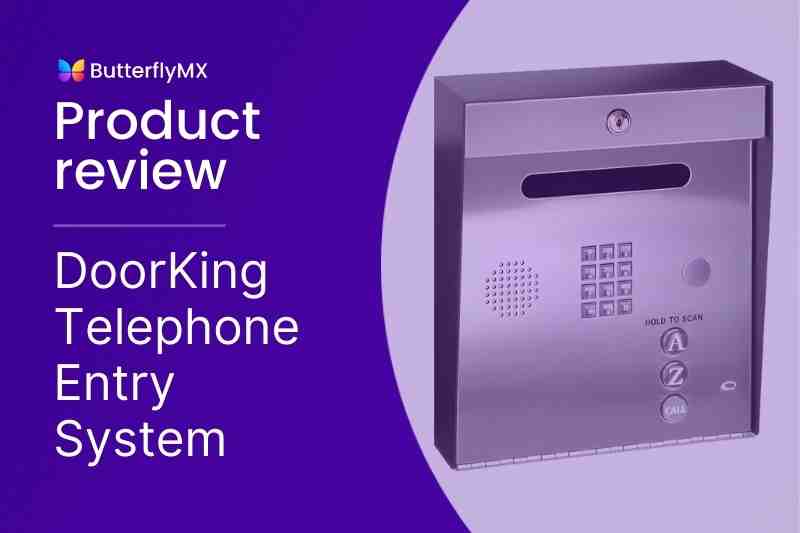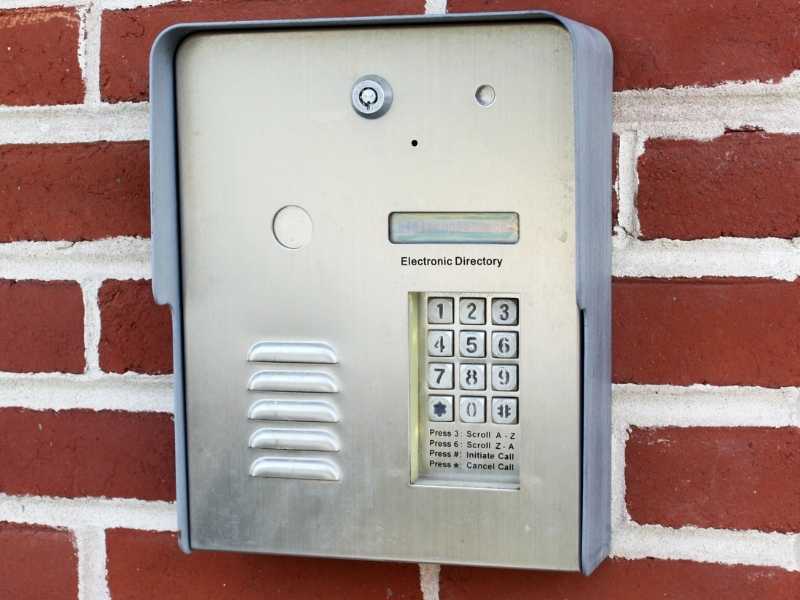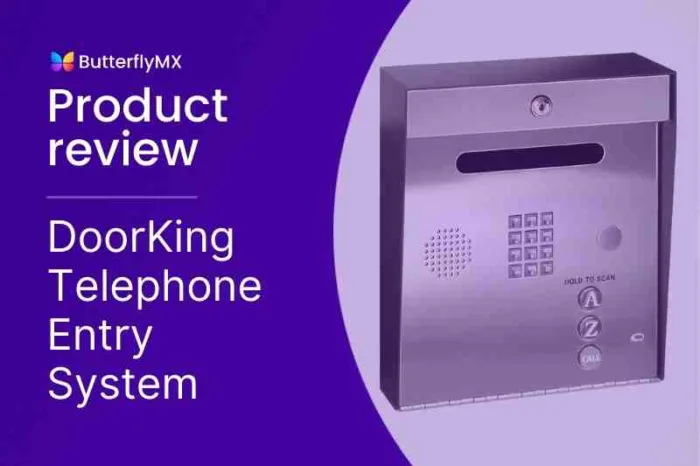Key takeaways
- Doorking (also known as DKS) is a well-known telephone entry system provider.
- Doorking offers more than a 10 phone entry system models, which vary in terms of features and functionality.
- Generally speaking, Doorking telephone entry systems may lack cameras and video calling, a mobile app for smartphone-based access, simple installation, and sleek touchscreen hardware.
- Instead of a Doorking phone entry system, you may want to consider an alternative, like a ButterflyMX smart video intercom.

When choosing a building entry solution, convenience, security, and ease of use are essential factors. A telephone entry system is one property access solution that gives staff and tenants more control over who has access to the building. And if you’re considering a telephone entry system, you might have heard of the Doorking telephone entry system.
But is Doorking your best option? Keep reading to find out!
This review covers all of Doorking’s telephone entry models and reviews their features, pricing, and pros and cons. Finally, it presents an alternative solution that may work better for your building.
This post covers:
- About Doorking
- Overview of Doorking telephone entry systems
- Features
- Doorking pricing
- Pros and cons
- Comparison of Doorking telephone entry systems with ButterflyMX Video Intercoms
About Doorking
Doorking (DKS) was established in 1948 in California, with headquarters in Inglewood, CA. Their products and materials are built and sourced in the USA. In the last seven decades, they’ve improved their supplier relationships and continued to work with domestic companies to support American businesses.
DKS started its operations in one location and later expanded nationwide. As a long-established entry solutions company, Doorking provides entry systems for government buildings, commercial facilities, and residences around the USA.
Doorking is supported by dealers, distributors, and regional offices throughout the country. They design and build their circuit boards in-house and maintain complete control over the quality of their products.
Watch how ButterflyMX works:
Overview of Doorking telephone entry systems
Some of Doorking’s most popular products are from their line of telephone entry systems. While the company offers more than 10 different series on its website, each model delivers slightly different features.
Here’s an overview of Doorking’s various telephone entry system series:
- 1802 & 1803: Comes in flush- and surface-mount models. Designed for residential and commercial sites with limited space. Both the 1802 and 1803 series lack a tenant directory, so they’re best for applications where you have a paper directory or don’t need one at all.
- 1810: Has a built-in lighted paper directory. Property staff must update the directory manually with a word processing program. So, Doorking 1810 entry systems may be best for small apartments and offices.
- 1812: An ultra-compact entry system with a numeric keypad, a single call button, and no directory. Comes in flush- and surface-mount models.
- 1833-80 series: Lacks a built-in paper or digital directory. Stores up to 3,000 phone numbers and 8,000 device codes. Can be programmed with cloud-based software (requires a paid subscription service).
- 1834-80 & 90 series: Offers the same features and functionality as the 1833 series but with a built-in digital directory and single-line LCD display. Can control up to two access points.
- 1837-80 & 90 series: Stores up to 3,000 phone numbers and 8,000 device codes. Cloud programming available with added subscription service. Additional elevator control module. Has a built-in digital directory with an eight-line LCD display.
Features
- All models available in flush- or surface-mount.
- DTMF tone output, which enables the entry system to be used with PBX and auto-attendant type phone systems.
- Certain models can store up to 3,000 phone numbers and 8,000 device codes.
- Cloud programming available for certain models when you purchase a software subscription service.
- Elevator control module included in certain models.
- Choose between models with no directory, paper directories, and digital directories.
- Some models provide access control via card readers, keypads, and relay board (which allows you to use existing Wiegand devices).
- Tamper alert switch
- Weather sealing on hardware
- Camera kits are available for many models at an extra cost (also requires added installation).
Doorking pricing
According to a January 2022 price sheet, Doorking telephone entry systems range in price from $1,496 to $7,040 for hardware. Exact pricing depends on which model you purchase.
And don’t forget: You’ll also have to budget for installation expenses and possibly service connection costs. Doorking’s VoIP adapter costs $180 while cellular service connection plans cost between $1,200 and $1,700.
To ensure you get the best price, get a quote through an authorized DoorKing distributor.

Pros & cons
Pros:
- DKS hardware is made in America.
- Weather- and tamper-resistant hardware.
- Doorking is a well-known telephone entry system provider that has been around for decades.
Cons:
- No touchscreen.
- No built-in camera or video calling functionality.
- Only some models have a digital tenant directory. Models with paper directories are a hassle to update, and some models don’t even have a directory at all.
- Only some models are compatible with Doorking’s cloud-based management software.
- Hardware may be clunky and may appear to lack aesthetics to modern users.
- May require a telephone line, which is expensive to install and maintain.
- To enable use with cell phones, you may need to purchase and install a DKS cellular connection box, sold separately.
Comparison of Doorking telephone entry systems with ButterflyMX Video Intercoms
When choosing an entry system, convenience, safety, and ease of use are priorities. Doorking telephone entry systems are used by many residential and commercial buildings — but are they the best?
Ultimately, Doorking telephone entry systems may not be the best property access solution for you. A better alternative, like a ButterflyMX Smart Video Intercom, will enhance security and convenience throughout your building.
For starters, DKS telephone system don’t have cameras or offer video calling. As a result, residents can’t see who’s requesting access before letting them in — which poses security risks. In contrast, ButterflyMX Video Intercoms offer both built-in cameras and video calling.
Additionally, many DKS phone entry systems don’t have a tenant directory, or force staff to print out paper directories every time someone moves in or out. This is a hassle for property staff and an inconvenience for visitors using the system. But with ButterflyMX, staff can manage the entire system from a web-based dashboard using any device. That means you can add or remove tenants, adjust access permissions, and control access from anywhere.
Finally, Doorking telephone entry systems may be difficult and expensive to install, whether you are laying telephone lines, running wiring throughout your building, or installing a DKS cellular connection box. In contrast, ButterflyMX is quick and easy to install, requiring just three connections: power, internet, and door strike. From there, residents simply use their own smartphones to remotely open doors and gates — no wiring or in-unit hardware required!
Doorking vs. ButterflyMX
If you want a powerful entry solution that makes property access simple for staff and residents alike, you may want to opt for the ButterflyMX Video Intercom instead of a Doorking telephone entry system. While Doorking may be a well-known provider, its products may not offer the features and functionality that modern tenants seek.
Disclaimer: ButterflyMX provides these blog posts to help our customers and potential customers make the right business decisions for them. Our blog posts are based on the information we have available to us at the time of writing.

Get your free quote!
Fill in the form below, and we'll email you right back.
Want a free quote?
Fill in the form below, and we'll email you right back.
You’ll be redirected shortly...







